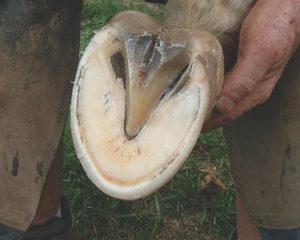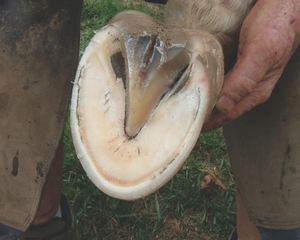Handy Hoof Hints, Part 5

Have you ever wondered what veterinarians think about barefoot and booting? A wealth of knowledge is now accessible to all of us. Read on to discover what today’s leading experts on hoof care have to say.
Dr. Tomas Teskey, DVM
“Every horse who wears steel shoes suffers some degree of laminar separation. There is a myriad of other malfunctions that also occur in a shod hoof, and they all contribute to the hoof functioning in a completely different and abnormal fashion and it leads to a severe contraction in their size, so much so that when the shoe is removed the horses can no longer walk comfortably on their own feet.
“For the presence of steel on a horse’s feet, we are able to observe profound damages that occur due to the stagnation of blood within the hoof and the diminished return of blood back up toward the heart through the veins of the lower leg. Metal shoes interfere with the hoof’s natural blood-pumping mechanism. Period.
“I will never ask any client of mine to consider shoeing their horse with steel. I have conviction in my belief about this and it is unwavering. I feel that farriers and veterinarians and trainers and horse people must learn the truth about this and tell their clients, friends, and colleagues that shoeing horses damages them and robs them of years of their lives.”
Dr. Tomas G. Teskey, DVM. The Unfettered Foot: A Paradigm Change for Equine Podiatry. Equine
Foot Science. 2005(25) page 78.
Dr. Robert Bowker, DVM
“The blood in horses’ feet does much more than provide nutrients to hoof tissues. It also enables the unshod foot to function as a hydraulic system, in much the same way that gel-filled athletic shoes do. We need to be trimming hooves so that more of the back part of the foot––including the frog––bears the initial ground impact forces and weight. Horseshoes provide a much smaller surface area to absorb shock. So, if a bare hoof landing after a jump experiences, say, 1,000 pounds of loading per square foot, then with a traditional shoe, there’s going to be 2,000 pounds per square foot.”
Luca Bein, Veterinary Medical Faculty Scientist, University of Zurich, Switzerland
“In 1984, the Swiss Cavalry conducted research into the effect of metal shoeing. Studies showed that the impact force a shod hoof receives on hard ground is 10 to 33 times that of an unshod hoof. The vibration in the hoof from the shoe is approximately 800 hertz. This level of vibration is high enough to destroy living tissue.”
From Horse & Rider, February 2006, “Is Barefoot Better?”
Dr. Robert Cook, FRCVS, PhD, Professor of Surgery Emeritus at Tufts
“All horses’ hooves are healthier without shoes, and barefoot horses are healthier than shod horses. They live longer, happier, less painful lives. Barefoot is a requirement for health and should be accepted as a condition for keeping a horse. Humane management is not just preferable, it is non-negotiable. The foot evolved to function unshod. Nature has developed the perfect design for grip and slide in all conditions and provided for unsurpassable shock absorption. The foot cannot expand and contract with each step when clamped. Blood supply to the foot is impoverished and horn production becomes deficient. When the foot is prevented from functioning correctly, the pastern, fetlock, cannon, and knee are also placed at risk. This leads to bone, joint, & soft tissue injuries.”
As reported by Marcia King. Barefoot vs. Shod. TheHorse.com: Your Guide to Equine Health Care. August 01, 2008 Article #12778

The Colorado Horse Source is an independently owned and operated print and online magazine for horse owners and enthusiasts of all breeds and disciplines in Colorado and surrounding area. Our contemporary editorial columns are predominantly written by experts in the region, covering the care, training, keeping and enjoyment of horses, with an eye to the specific concerns in our region.

